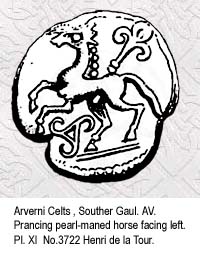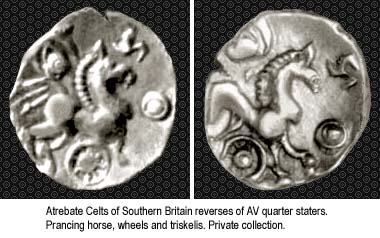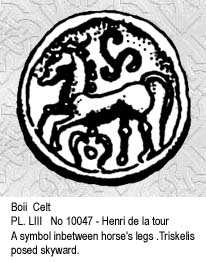|
|
Page V |
|
|
|
|
|
|
|
|
|
|
|
|
|
|
 |
|
|
|
|
|
|
|
|
|
|
|
|
|
|
|
 |
|
|
|
|
|
|
|
Part III - Western Europe |
|
|
|
|
|
|
|
|
|
|
|
|
|
|
|
|
|
|
|
|
|
|
|
|
|
|
|
|
|
Alike the triskelis, Etruria
departed leaving behind unanswered questions. This civilization
is recorded ca. 900 B.C. thriving
freely beneath Italian blue skies till five centuries later, their
Roman neighbours decided otherwise. Thereuntil Etruria represented
Italic culture, presence and politics .
It would seem Etruscans portrayed triskeles through art rather than
coins. Unfortunately no literature survives defining symbolic relevances.
Their art forms, well researched, prove Corinthian and Attican cultures
amongst other Hellenic inspirers. Territorially they dominated from
Rome till the Po Valley, naming themselves Rasenna whilst
the Greeks chose Tyrrhenians considering prince Tyrrhenus, led his
people to Etruria’s shores as Herodotus related. |
|
|
|
|
|
|
|
|
|
|
|
|
|
|
|
|
|
Earliest known written
Etruscan appears ca. 650 B.C. (some say
in adopted Chalkidic — See Euboea). Alike Sumer, Lycia and others,
their writing system is considered unusual, Greek in its alphabet
yet grammatically unlike European languages or so it would seem. (Future
archaeological research may soon enlighten us). Etruria lagged behind
producing coinage, seemingly awaiting the Greek poleis of Magna Graecia,
meanwhile accepting Greek coinage for trade. It appears their own
mints were tardily conceived during the third
century B.C. |
|
|
|
|
|
|
|
|
|
|
|
|
|
|
|
|
|
Today’s Etruscology
sets Orientalising years 600 to 300 B.C.
Apparently immigrants arriving via Asia Minor during the 6th century,
victims of Persian expansion, some experts believe they were Lydians.
If correct, again stand two known possibilities justifying the symbol’s
arrival into Etruria, lest Etruscans brought it with them, if indeed
they did not originate within today’s lands of Italy — another
contradictory subject regarding Etruscans. Although we sought an “Etruscan
triskelis” we shamefully admit failure, offering not even the
hint of an ankle. Numerous authors mention having seen such, thus
doubly frustrating. We searched every pot, jar and vase we could find.
We even snooped the tombs! What we chiefly remember throughout this
search is a certain marvellous Etruscan smile of discreet hilarity. |
|
|
|
|
|
|
|
|
|
|
|
|
|
|
|
|
|
It is striking to
discover triskelis continuity after 210 B.C
following Rome’s takeover of Sicily. Certain specialists date
Rome’s coinage system to
269 B.C. Roman minting adroitly maintained
the Island’s symbol and that of Victory (Nike). We encounter
Trinacrus (enigmatic personage) leaning a foot upon a Roman war-vessel,
therewhile holding or twirling a triskelis with his right hand. [
24 ] Another Roman issue designates L. Sempronius Atratinus,
Commander during the appointment of M. Antonius. The obverse offers
Demeter's head behind which the symbol appears. Later, Roman Sicily
minted a 47 B.C. silver denarius under
proconsul A. Allienus, producing on behalf of Julius Caesar. A diademed
head of Venus turns to an obverse depicting Trinacrus anew, “holding”
a triskelis. The occasion is Caesar’s Sicilian based preparations
readying attack upon Scipio the Pompeian away in North Africa. (Part
1 presents both coins). Is Trinacrus stilling the triskelis spin ,thus
representing not Sicily but Roman domination, or is he clasping it
after a nod of approval from mighty Rome? Further Roman issues are
struck for Sicily under L. Cornelius Lentulus and C. Claudius Marcellus,
the latter in 49 B.C. and Panamoros observed
its triskelis reappearing upon bronze coins honouring Augustus. Varying
triskelis reverses occurred, with and without Gorgoneion centres.
[
72 ] |
|
|
|
|
|
|
|
|
|
|
|
|
|
|
|
|
|
Tunis’s Bardo
Museum displays amongst its world-famous mosaics a representation
of Rome as Athena (Minerva). Surrounding her, six allegories represent
the Provinces with goddess Diana portraying Sicily. From behind her
head emerges the legs of the Sicilian triskelis. www.di.com.tn/africa/africa_ang/rome.htm
The significance of the Island's present-day symbol may contain a
mythological source. Is Trinacrus an indication of Sicilian or Roman
choice in maintaining the symbol? Or is Athena at the root of it? |
|
|
|
|
|
|
|
|
|
|
|
|
|
|
|
|
|
|
 |
|
|
|
B. Schenck
|
|
|
|
|
|
|
|
|
|
|
|
|
|
|
|
|
|
|
|
|
Celts,
keltoi, were the “hidden” people Hecataeus identified
(546-480 B.C.) and La Tène
timing has been placed similarly, (500 B.C).
Author Nigel Pennick situates Celts entwining Greek and Etruscan
forms with that of Hallstatt, to approximately 650
B.C. A triskelis concept may indeed have inspired these tribal
people whilst in Greece, considering their significant numbers as
hired mercenaries battling about the lands of Zeus. Spirals, which
Celts frequently used, when grouped in three’s, are occasionally
termed Celtic triskelions, yet spiral representations priorly existed,
for example, various museums display 16th
century B.C. gold Mycenaean cups and 15th
century Babylonian pottery (all with spirals), etc., therefore
we shall not dwell upon this, but exclusively retain ibis-beaked
forms (Naqsh-I-rajab) trumpet shaped (Lycia), or “triangled”
and Eastern style (India-Soghdiana). Many of these the Celts used,
perhaps admiringly imitative as they were of Greek coinage, albeit
adding a delightful, unique flair. *12
- A few spiral exceptions shall be seen here concerning the drawings
of Henry de la Tour.[
25 ] |
|
|
 |
|
|
|
|
|
|
|
|
|
|
|
|
|
|
|
|
|
|
|
|
|
|
We quote the Numismatic
Museum of Athens explaining Celts were not only mercenaries in the
area: |
|
|
|
|
|
|
|
|
|
|
|
|
|
|
|
|
|
“The coinage of Alexander the Great
had great impact on the Celts, who had penetrated the Balkans massively
from the early 3rd cent. B.C. onwards. Some imitations could have
been issued by the Skordiskoi, a Celtic tribe that lived mainly in
the present-day region of Srem, expanding later into (modern) Serbia
and NW Bulgaria.” |
|
|
|
|
|
|
|
|
|
|
|
|
|
|
|
|
|
Part 1 offers triskelis images or coins issuing
from: the Danube belt up to the Netherlands (Vindelici
gold staters) and Gaul’s Bituriges
Cubi. It also offers: an unusual Celtic shield found
in Brescia, Italy, a gold tetradrachm of the Eastern
Danube (comparable samples [
26 ][
27 ] ), and a Cotini
tetradrachm. The Danubian Celts lived across the famous River facing
Thrace and Dacia. Legend tells the river’s mouth enclosed the
death haunt of the Trojan war’s Ajax and Achilles.
Migratory Celts settled vast expanses commencing about 500
B.C. (400 B.C. in Italy). The Cimbri
and Teutones settled in Germany
and Rhineland Germanii produced electrum staters depicting a full
triskele obverse, the reverse decorated with annulets, sometimes
as many as six. The Celts of Gaul and
Switzerland sacked Rome, rampaged throughout Greece (278
B.C.), settled for some in Asia Minor (the Galatians)
whilst others spread into Iberia or Italy. The Romans discouraged
Celtic straying by the 3rd century B.C. |
|
|
|
|
|
|
|
|
|
|
|
|
|
|
|
|
|
|
|
Time
discourages sifting through enumerable Celtic tribes in search of
triskeles. The field is too vast but readily available samples are:
a gold stater of Vercingetorix's Arverni Celts, a triskelis tumbling
midst the legs of a five-legged horse [
28 ] followed by a Caletes issue depicting another horse, with
behind what imaginatively resembles a fleur de lys pommeled staff
or lance.*19
[ 29 ]. These circulated mid-second century A.D., the century
Carnutes of Central Gaul produced drachms designed with a dog or wolf
having a happy ride of it.[
30 ] |
|
|
 |
|
|
|
|
|
|
|
|
|
|
|
|
|
|
|
|
|
|
|
|
|
|
Another tribe assisting
Vercingetorix , the Petrocorii
of the Périgueux / Périgord whom the Romans assimilated
into Aquitaine, issued triskelis coins [
54 ] [
69 ] (see similarity with n°25 above). The Lingons of Langres,
Gaul, staunch allies of Rome, produced a double-faced triskelis specie
(see n° 53 pg 6). Needless mentioning Celtic stylisations created
the largest number of variants known. One such example may be found
in the book of Henri de la Tour 1982 edition : PL.XXXIX numbers 9942
/ V.22, the latter bearing an “Odin” shaped triskelis described
in part 1- Storia |
|
|
|
|
|
|
|
|
|
|
|
|
|
|
|
|
|
Britain’s Atrebates
sometimes shifted triskeles skyward, their half staters judged up
to date the Island’s earliest (about 75
B.C.). [ 31 ]
The first and second centuries B.C. set this tribe amongst Celts
prevailing in the land. Their attachment to Gaul and support
of Vercingetorix remaining firm throughout victory or defeat eventually
brought Rome's disfavour allowing enemy Trinovantians to supplant
their influence, encouraged thus by Julius Caesar 54 B.C. Less Romanised,
north and west Britain preserved Celtic culture notwithstanding
settlement of Germanic kingdoms. Today's Wales has fortunately upheld the language.(Further
language information: http://iiasnt.leidenuniv.nl/pie/ielangs/celtic.html).
Britain's uninscribed Corieltauvi
(Coritani) issues encircled triskeles concurrently with Corinth
(see coin n°15), reversing its position to the obverse. [
68 ] Third century B.C. triskeles shaped as coin N° 27
or 54 were discovered at the Kirkburn burial site in East Yorkshire.
These bronze linchpins served to secure chariot wheels and may be
seen today at the British Museum. |
|
|
|
|
|
|
|
|
|
|
|
|
|
|
|
|
|
A ladder-maned horse
trots across a Boii issue, similarly
styled to those above.[
32 ] Traditionally located in Bohemia, the Boii, ever on the
move, strayed into Moravia , Slovakia, Italy, France, and Bohemia.
Possibly the name Bohemia derives from these Celts.
With apologies to the author whose name we misplaced in our triskelis
chase, we cannot resist quoting his philosophical thoughts, hoping
meanwhile he shall come forth in order we identify him in this site.
His words crystallize impressions we felt while viewing Celtic coins
with their swirling suns, stars, moons, running horses or diversely
formed triskeles. |
|
|
|
|
|
|
|
|
|
|
|
|
|
|
|
|
|
“While the
ancient Celts felt no need to attribute meaning to their designs,
there is nothing to prevent the modern viewer from assigning significance.
It might even be argued that from a Jungian view of the collective
unconscious, that the meaning was always there but hidden during the
act of creation and revealed in their contemplation.” |
|
|
|
|
|
|
|
|
|
|
|
|
|
|
|
|
|
|
 |
|
|
|
Caletes Celts, Northern Gaul.
No 7221 PL. XXIX -
Henri de la Tour
|
|
|
|
|
|
|
|
|
|
|
|
|
|
|
|
|
|
|
|
|
|
|
|
|
|
|
|
|
Two Celtic coins found on the Island of Jersey.
[ 33 ] - [
34 ] |
|
|
|
|
|
|
|
|
|
|
|
|
|
|
|
|
|
|
|
|
|
|
|
|
|
|
|
|
|
|
|
|
|
|
|
|
|
|
|
|
|
|
|















